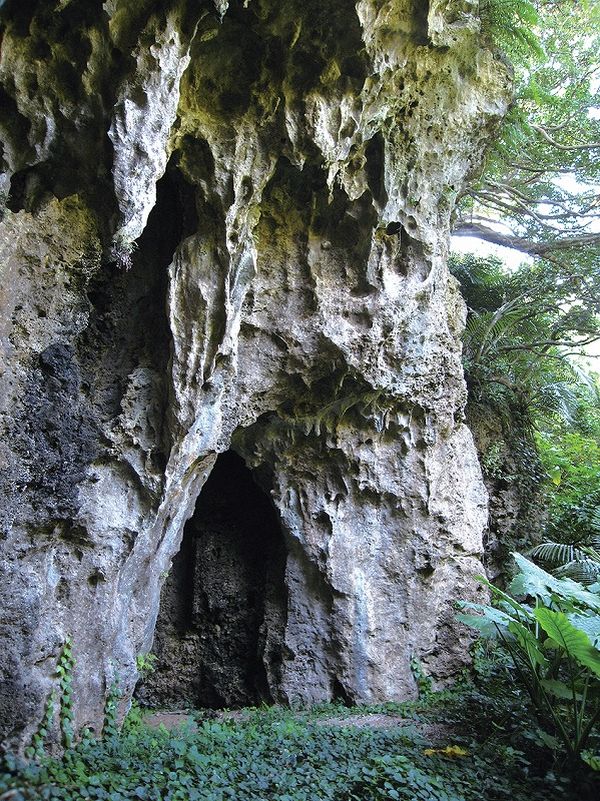トップ > 市の組織 > 教育委員会 > 生涯学習部 > 生涯学習振興課 > 【市指定天然記念物・地質】 大竹中洞穴
【市指定天然記念物・地質】 大竹中洞穴
〔うぶたきなかどうけつ〕
佐和田線と基幹農道との交差点の東北側500m程の所、土地改良区内にある。1977(昭和52)年12月18日、琉球大学の野原朝秀教授等によってミヤコノロジカの化石片が発見され、1999年3月には、人の歯の化石も見つかっている。大竹中洞穴は杓文字(しゃもじ)型をした広い陥没ドリーネの崖面にあり、この横穴洞とドリーネの形成は伊良部島の地質学上貴重なところである。
170万年前から120万年前は、宮古列島は大陸と陸続きになっており、大陸から、シカ・ゾウ・イノシシ・リュウキュウケナガネズミ・ハブ等が渡ってきたと考えられている。また、5万年前から6万年前には隆起運動が活発になり、宮古列島が隆起珊瑚礁の島として存在してくる。その後2万年程前にも大陸と陸続きになる。その頃、いろんな生き物や現生人類(新人)が、大陸から渡ってきたと考えられている。この洞穴は、人類の移動を考える上でも貴重な遺跡である。
【Natural Monument (Geology) Designated by the City】 Ubutakinaka Cave
It is located inside a land improvement district, about 500 m northeast of an intersection of the Sawada Route and the main farm road. On December 18, 1977, fossil pieces of Miyako-norojika (extinct roe deer) were discovered by Professor Tomohide Nohara of the University of the Ryukyus and others. In March 1999, fossils of human teeth were also found. Ubutakinaka Cave is situated on the cliff side of an extensive collapse doline which takes a rice scoop shape. The formation of this lateral cave and a doline is important in terms of geology in Irabu Island.
It is considered that 1.7 to 1.2 million years ago, the Miyako Islands were connected to a continent where deer, elephants, wild boars, Ryukyu-kenaga-nezumi (long-haired rat), habu (venomous snake) and others came from. Between 50,000 to 60,000 years ago, upheavals actively took place, and the Miyako Islands emerged as islands of elevated coral reef. Then, about 20,000 years ago, the islands once again were connected to the continent. Around that time, various creatures and modern human beings are considered to have crossed over. The cave is a valuable site in understanding the migration of human beings.
【市指定天然紀念物・地質】 大竹中洞穴
位於距離佐和田與主幹農路交叉口東北側,约500公尺處的土地改良區內。1977年(昭和52年)12月18日,琉球大學教授野原朝秀等人發現了宮古麋鹿的化石片,1999年3月又發現了人類的牙齒化石。大竹中洞穴位於呈飯杓型的巨大岩溶漏斗的崖面上,這個橫穴洞和岩溶漏斗的形成,在伊良部島的地質學上具有重要一席。
一般認為,距今170萬年前至120萬年前,宮古列島與大陸連在一起,從大陸遷移過來了鹿、象、野豬、琉球長毛鼠、波布蛇等動物。另外,距今5萬年前至6萬年前,地殼運動非常活躍,宮古列島因珊瑚礁隆起而形成半岛,直到2萬年之前還與大陸連在一起。從那時起,許多生物和人類來自大陸。這個洞穴在思考人類的移動上,是非常珍貴的遺跡。
【미야코지마시 지정 천연 기념물・지질】 우부타케나카 동굴
사와다선과 기간 농업도로와의 교차지점의 동북쪽 500m정도의 토지 개량 지구 내에 있다. 1977년12월18일 류큐대학의 노하라 도모히데 교수 등에 의해 미야코노로지카의 화석 조각이 발견되었다. 1999년3월에는 사람의 치아 화석도 발견되었다. 우부타케나카 동굴은 주걱형의 넓은 함몰 돌리네의 언덕면에 있고, 그 횡혈 동굴과 돌리네의 형성은 이라부섬의 지질학상 귀중한 것이다.
170만년 전부터 120만년 전 미야코열도는 대륙과 연속면에 있었으므로, 대륙에서 사슴, 코끼리, 멧돼지, 류큐게나가네즈미(쥐), 뱀 등이 건너온 것으로 추측된다. 또한 5만년 전부터 6만년 전에는 융기운동이 활발해져 미야코열도가 융기산호초의 섬으로써 존재하였다. 그로부터 2만년여 전에도 대륙과 연결된다. 그 즈음, 다양한 생물과 구석기 시대 후기의 인류가 대륙에서 건너온 것으로 추측된다. 이 동굴은 인류의 이동을 고찰하는데 있어서도 귀중한 유적이다.
生涯学習部 生涯学習振興課
電話:0980-72-3764






